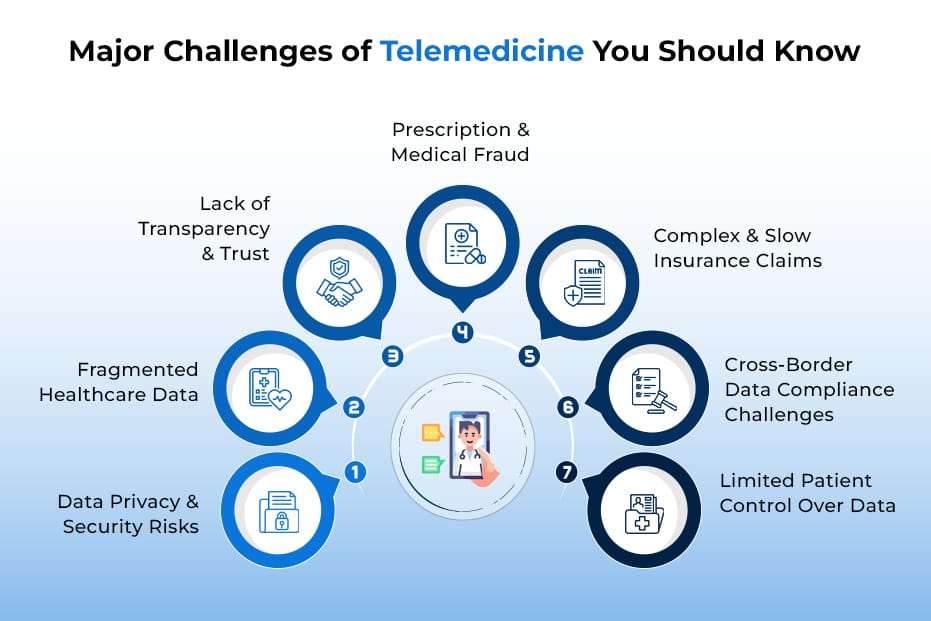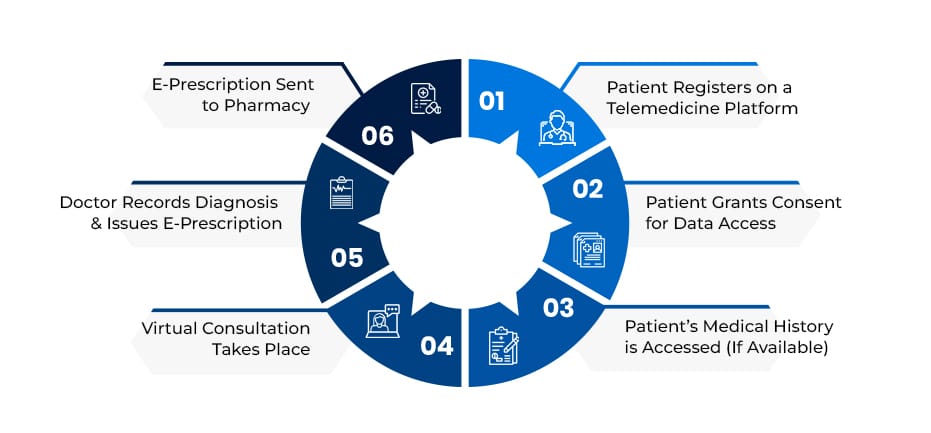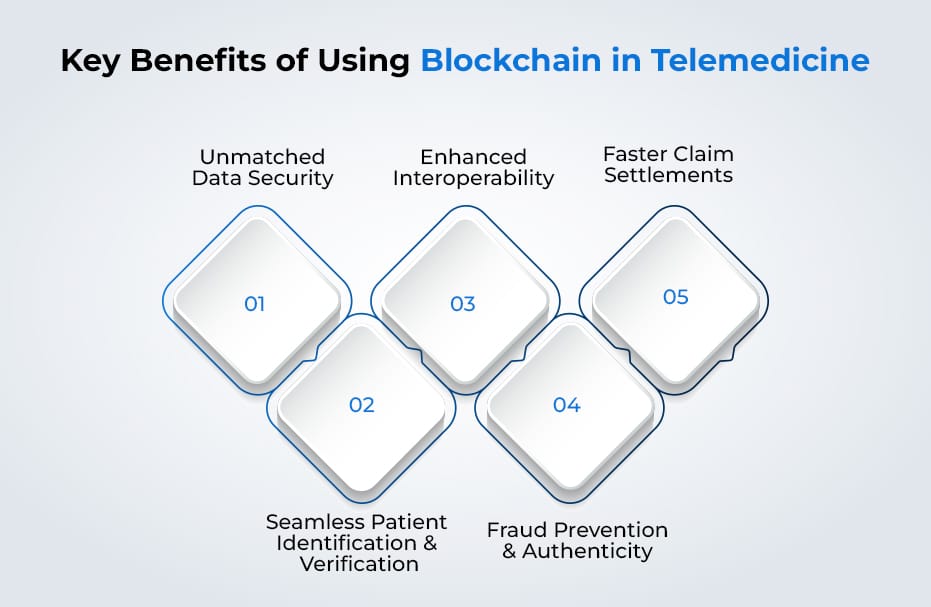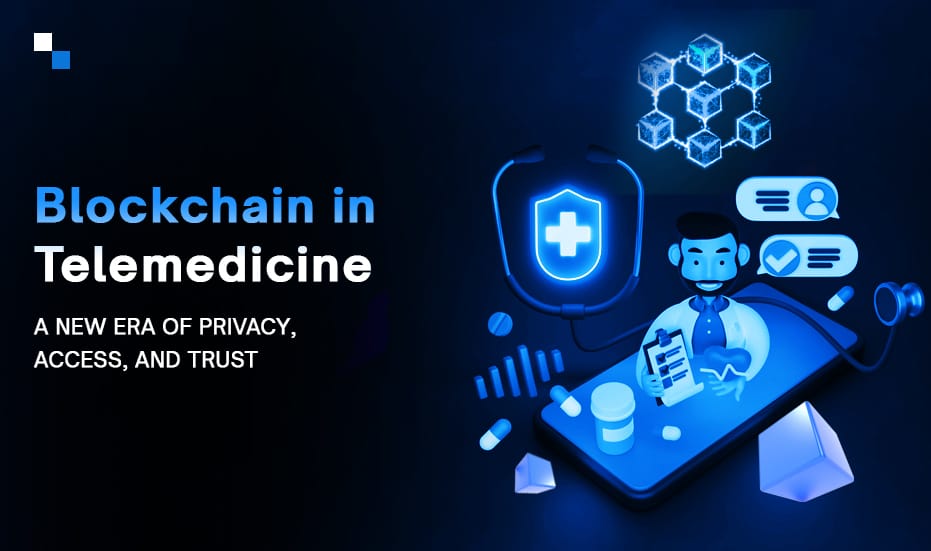
Exploring the Best Mobile Wallet App Development Companies- 2025
April 8, 2025
Why Prediction Platforms Are the Next Big Thing for Crypto Exchanges?
April 9, 2025The telemedicine sector is touching new heights of growth. According to Grand View Research, the global telehealth market size was estimated at USD 101.15 billion in 2023 and is projected to grow at a CAGR of 24.3% from 2024 to 2030. The way telemedicine brings convenience to the lives of people by connecting them with a certified doctor via video call and receiving a digital prescription on their app, this industry will continue to grow. But behind this seamless experience lies a major concern: how do telemedicine platforms ensure the sensitive health data shared in these virtual consultations stays private, secure, and tamper-proof? From patient medical histories to prescriptions and insurance claims, every digital transaction needs to be protected with ironclad security.
This is where blockchain in telemedicine steps in and completely flips the game. Blockchain introduces a decentralized, transparent, and secure framework, which addresses the challenges that have held telemedicine back from reaching its full potential.
In this blog, we’ll dive deep into the urgent challenges telemedicine faces today, explain how blockchain technology solves these issues step by step, real-world use cases and applications, and why blockchain is becoming the digital backbone of modern virtual healthcare.
The Hidden Challenges of Telemedicine You Need to Know
Telemedicine isn’t new. The COVID-19 pandemic accelerated its adoption, with millions turning to virtual consultations. However, rapid adoption brought hidden challenges-

1. Data Privacy & Security Risks
Telemedicine platforms collect and exchange highly sensitive patient data, such as medical histories, prescriptions, personal identifiers, and insurance details. Unfortunately, most platforms store this information on centralized servers, which makes them prime targets for cyberattacks, ransomware, and data breaches.
What’s at stake:
- Exposure of confidential health records
- Identity theft and insurance fraud
- Loss of patient trust
- Regulatory penalties for non-compliance
2. Fragmented Healthcare Data
Telemedicine platforms often operate in isolation, without integration with hospitals, pharmacies, insurance providers, or diagnostic labs. As a result, patient data is fragmented across different systems.
The consequences:
- Lack of a unified patient health record
- Medical errors due to incomplete or outdated information
- Poor coordination between healthcare providers
- Repetitive tests and consultations
3. Lack of Transparency & Trust
Virtual healthcare removes face-to-face interactions, which naturally increases patient skepticism. Patients have little visibility into how their data is stored, who can access it, and how it’s being used behind the scenes.
This creates:
- Doubts about the credibility of telemedicine platforms
- Fear of data misuse or unauthorized sharing
- Reluctance to adopt virtual healthcare services
4. Prescription & Medical Fraud
In a virtual setup, verifying the authenticity of e-prescriptions and doctor credentials is complex. Cases of fake prescriptions, identity fraud, and misuse of patient data are alarmingly common.
The risks:
- Circulation of fraudulent prescriptions
- Unauthorized access to medications
- Increased insurance fraud cases
5. Complex & Slow Insurance Claims
Telemedicine has added new layers of complexity to healthcare billing and insurance claims. Disputes over service authenticity, claim eligibility, and lack of verified consultation records are frequent.
This leads to:
- Delayed reimbursements for patients
- Increased administrative overhead for insurers
- Frustration and mistrust in the telemedicine process
6. Cross-Border Data Compliance Challenges
Telemedicine platforms often operate globally, but healthcare regulations vary across regions. Ensuring compliance with privacy laws becomes a logistical nightmare when patient data is shared across borders.
What’s at risk:
- Non-compliance fines and lawsuits
- Legal complexities in data-sharing
- Loss of business credibility
7. Limited Patient Control Over Data
In most telemedicine platforms, patient data is controlled by platform owners or healthcare providers, not by the patients themselves. Patients have limited knowledge of how their data is shared, stored, or deleted.
This creates:
- Dependency on third-party platforms
- Zero visibility for patients over their medical records
- Growing privacy concerns
Blockchain in Telemedicine- A Game-Changer
Blockchain in telemedicine is a game-changer because it addresses these challenges head-on. It creates an unhackable digital trail of every patient record, transaction, and interaction, which keeps patient data secure, authentic, and easily accessible for authorized personnel.
But how exactly does blockchain work in the telemedicine space? Let’s break it down.
How Blockchain Works in Telemedicine — Step-by-Step Process

Step 1: Patient Registers on a Telemedicine Platform
The patient signs up on a blockchain-powered telemedicine platform using a secure digital identity. This ID is stored on the blockchain and becomes their unique access point for all future healthcare interactions.
Step 2: Patient Grants Consent for Data Access
Before any data is shared, the patient gives explicit consent (digitally signed). This consent is recorded immutably on the blockchain, which ensures transparency and legal compliance.
Step 3: Patient’s Medical History is Accessed (If Available)
With consent, the telemedicine system retrieves the patient’s medical records from previous consultations or connected healthcare providers. These records are stored as encrypted data blocks, not in one central location, but across a decentralized network.
Step 4: Virtual Consultation Takes Place
The patient has a video or voice consultation with a certified doctor. During the consultation, the doctor can view relevant records (medical history, allergies, prescriptions) in real-time, which promises an accurate diagnosis.
Step 5: Doctor Records Diagnosis & Issues E-Prescription
After diagnosis, the doctor submits their notes and an e-prescription. This information is automatically logged on the blockchain with a timestamp and digital signature. No one, not even the platform, can alter these records.
Step 6: E-Prescription Sent to Pharmacy (Optional)
If the patient chooses, the e-prescription is shared with a pharmacy or lab. As this data is recorded on blockchain, the pharmacy can verify the authenticity instantly. The immutable consultation log and treatment details can be shared with the insurance provider (with patient permission). Smart contracts can even trigger automatic claims processing and approval based on pre-set conditions.
From patients to doctors, insurers to pharmacists, everyone involved has transparent, real-time, and permission-based access to the exact same, unalterable record of the telemedicine transaction.
Top Benefits of Integrating Blockchain in Telemedicine Platforms
While telemedicine has opened new doors for healthcare access, blockchain takes it a step further by adding trust, transparency, and security to every virtual interaction. Here are the key benefits that make this tech duo a perfect match.

1. Unmatched Data Security
Patient data is sensitive. A single breach can expose medical histories, insurance information, and even financial data. Blockchain’s decentralized structure and encryption protocols make unauthorized access nearly impossible. Each transaction is time-stamped and immutable.
2. Seamless Patient Identification & Verification
Blockchain allows patients to have a unique, universal digital identity. This eliminates the need to re-verify identity across different hospitals or telemedicine apps. Patients can control who accesses their data and when.
3. Enhanced Interoperability
One of the biggest pain points in healthcare is data silos. Blockchain applications in telemedicine bridge this gap. Doctors, hospitals, pharmacies, and insurers can securely share patient data across platforms, enhancing coordination and minimizing errors.
4. Fraud Prevention & Authenticity
Fake prescriptions, duplicate diagnostic reports, and identity fraud are serious issues in virtual healthcare. Blockchain ensures that every record is traceable to its source, leaving no room for manipulation.
5. Faster Claim Settlements
Since blockchain stores verified consultation logs and prescriptions, insurance companies can process claims without the usual paperwork chaos. It leads to faster reimbursements and fewer disputes.

Real-World Blockchain Applications in Telemedicine
Let’s look at real-world blockchain applications in telemedicine, showing how this technology is changing the game.
-
Remote Consultations with Verified Medical History
Blockchain allows doctors to instantly access verified patient data—past prescriptions, allergies, lab results—without relying on fragmented records. This leads to better diagnosis and treatment.
-
Cross-Border Virtual Treatments
For patients seeking international telemedicine consultations, blockchain ensures compliance with regional data privacy laws like GDPR and HIPAA, which reduces legal complexities to a great extent.
-
Tamper-Proof E-Prescriptions
Blockchain can store e-prescriptions securely. It ensures that patients receive authentic prescriptions that cannot be altered or duplicated.
-
Decentralized Telemedicine Platforms
Instead of relying on a single centralized telemedicine service, blockchain enables decentralized platforms where doctors and patients can connect peer-to-peer, cutting costs and improving accessibility.
These are just a few examples of how blockchain applications in telemedicine are already reshaping healthcare delivery models worldwide.
How Antier Can Help You Build Blockchain-Driven Telemedicine Apps
If you’re wondering how to get started with blockchain-based telemedicine app development, you’re in the right place.
At Antier, we specialize in developing future-ready, scalable, and secure blockchain solutions tailored to the healthcare industry. From designing decentralized telemedicine platforms to integrating blockchain into your existing healthcare infrastructure, we cover everything.
Our team offers end-to-end blockchain healthcare app development services, including:
- Blockchain architecture & smart contract development
- Telemedicine platform development with blockchain integration
- Compliance-ready solutions
- Custom patient identity management systems
- Interoperability frameworks to connect with existing healthcare systems
- Post-deployment support & maintenance
At Antier, we don’t just develop apps. We create robust, trust-driven ecosystems where patients, doctors, insurers, and healthcare providers can thrive securely.
Final Thoughts
Blockchain in telemedicine increases data security, builds trust, enhances patient experience, and future-proofs healthcare delivery. Whether you are a telemedicine startup or an enterprise healthcare provider, blockchain offers the missing piece to your digital healthcare puzzle. So, if you’re ready to redefine virtual healthcare and stay ahead of the competition, it’s time to explore blockchain-powered telemedicine solutions.
Contact us today and let us help you build a scalable, secure, and compliant telemedicine platform powered by blockchain.



